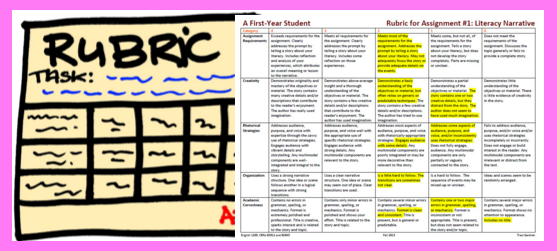

Types of rubrics:
- Holistic – assign one score to performance
- Analytic – assign multiple scores to multiple factors that evaluate performance
- Analytic rubrics communicate more information than holistic rubrics
Rubric purposes:
- communicate criteria for evaluating performances and products when there is no single correct answer to the challenge
- communicate expectations to students
- establish consistent ways to evaluate performances and products
Rubric writing suggestions:
- develop rubrics for understanding (content) and performance quality (21st century rubrics)
- derive criteria from targeted standards. One method:
- Use VERB in standard for proficient column
- Use VERB that is a lower Bloom’s verb than standard VERB for emerging column. Select a verb that describes an skill that supports the development of the targeted skill.
- Use VERB that is a higher Bloom’s verb than standard VERB for advanced column. Select a verb that describes an enrichment task relative to criteria in proficient column
- double check that targets align with learning targets
- use 6 facets of understanding to develop advanced criteria
- do not confuse “just engaging” assessments with “engaging AND valid” assessments
- use past student work
- divide student work into piles of similar quality
- cluster reasons that unite piles into traits
- write a definition for each trait
- select samples that illustrate each trait
- continually refine
- rubric evaluating questions:
- could student do well on this task without understanding key learning goals?
- could student do poorly on this task while understanding key learning goals?
Rubric implementation tips:
- use rubric to evaluate exemplars and provide rationales for scores
- use rubrics to give formative feedback from teacher, self, and peers throughout the project
- use rubric feedback to refine products

Rubric criteria are needed to evaluate responses to open-ended questions and to measure levels of understanding. Rubric criteria help communicate clear communication expectations. They make evaluations more clear, consistent and fair. Designing aligned rubrics ensures that the performances we require from students demonstrate mastery of targeted standards. Criteria can steer attention from correctness to levels of understanding. Evaluating rubrics can help us make inferences about what students are learning.

Preparation Steps
- Analyze NOUNS, VERBS and CONTEXTS in targeted standards.
- If possible, analyze student work using method describe above.
- Use analysis of student work and standards to develop rubric criteria.
- Ask for feedback on rubric from teachers and student – check for alignment (from other teachers) and clarity (from students).
Early Implementation Steps
- Distribute rubrics to students early in the project
- Let students analyze rubric using tools such as Knows & Need-to-Knows charts and GRASPS – see this article for more on GRASPS
- Use rubrics to generate teacher, self, and peer feedback that students use to improve understanding and product
- Clarify expectations by evaluating exemplars using rubrics and providing rationales for scores and concrete tips for achieving criteria.
Advanced Implementation Steps
- Guide students to seek out multiple exemplars and use their common traits to develop rubric criteria. For more info on how to use models to generate rubric criteria – see this article: Models, critique, and descriptive feedback
- Use rubrics and related tools to guide students in goal setting and tracking progress towards those goals over time


 Chapter 8 in
Chapter 8 in
Wishing you the best of luck for all your blogging efforts. This is my first opportunity to chat this website I found some interesting things and I will apply to the development of my blog.
Cubical Solution